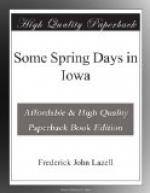* * * * *
Each flower invites admiration and study. Dig up the root of the Solomon’s seal, a rootstock, the botanists call it. It is long, more or less thickened and here and there is a circular scar which marks the place from which former stems have arisen. When these leaf-bearing stems die down they leave on this rootstock down in the ground, a record of their having lived. The scar looks something like a wax seal and the man who gave the plant the name of Solomon’s seal had probably read that tale in the Arabian Nights, where King Solomon’s seal penned up the giant genie who had troubled the fishermen.
Then there’s the May-apple. Who does not remember his childhood days when he pulled the little umbrellas? Even now as they come up in little colonies, they call up memories of the fairy tales of childhood and we almost expect to see a fairy, or a brownie, or Queen Mab herself, coming from under them, when the summer shower, which makes their tops so beautifully moist gray, has passed. And they also bring to mind that charming first edition of Dr. Gray’s botany, which had in it much of the man’s humor as well as his learning. Too bad that the learned scientists who succeeded him have cut it out. “Common Honesty, very rare in some places,” he wrote, speaking of that plant. “Ailanthus, Tree of Heaven, flowers smell of anything but heaven,” was his comment on the blossoms of our picturesque importation from China. And when he came to the May-apple he wrote that the sweetish fruit was “eaten by pigs and boys.” This made William Hamilton Gibson remember his own boyish gorgings and he wrote: “Think of it boys. And think of what else he says of it: ’Ovary ovoid, stigma sessile,




